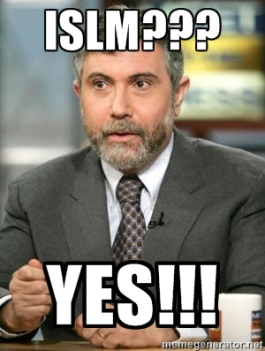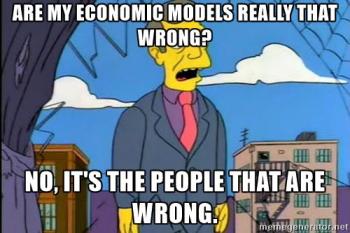Krugman vs Syll on the IS-LM model Some time ago yours truly ventured to question Paul Krugman for his unadulterated devotion to the IS-LM model. For years self-proclaimed “proud neoclassicist” Paul Krugman had in endless harpings on the same IS-LM string told us about the splendour of the Hicksian invention. Krugman’s response contained nothing new. In an earlier post on his blog, Krugman had argued that ‘Keynesian’ macroeconomics more than anything else “made economics the model-oriented field it has become.” In Krugman’s eyes, Keynes was a “pretty klutzy modeler,” and it was only thanks to Samuelson’s famous 45-degree diagram and Hicks’s IS-LM that things got into place. Although admitting that economists have a tendency to use ”excessive math” and
Topics:
Lars Pålsson Syll considers the following as important: Economics
This could be interesting, too:
Lars Pålsson Syll writes Schuldenbremse bye bye
Lars Pålsson Syll writes What’s wrong with economics — a primer
Lars Pålsson Syll writes Krigskeynesianismens återkomst
Lars Pålsson Syll writes Finding Eigenvalues and Eigenvectors (student stuff)
Krugman vs Syll on the IS-LM model
 Some time ago yours truly ventured to question Paul Krugman for his unadulterated devotion to the IS-LM model. For years self-proclaimed “proud neoclassicist” Paul Krugman had in endless harpings on the same IS-LM string told us about the splendour of the Hicksian invention.
Some time ago yours truly ventured to question Paul Krugman for his unadulterated devotion to the IS-LM model. For years self-proclaimed “proud neoclassicist” Paul Krugman had in endless harpings on the same IS-LM string told us about the splendour of the Hicksian invention.
Krugman’s response contained nothing new. In an earlier post on his blog, Krugman had argued that ‘Keynesian’ macroeconomics more than anything else “made economics the model-oriented field it has become.” In Krugman’s eyes, Keynes was a “pretty klutzy modeler,” and it was only thanks to Samuelson’s famous 45-degree diagram and Hicks’s IS-LM that things got into place. Although admitting that economists have a tendency to use ”excessive math” and “equate hard math with quality” he still vehemently defends — and always have — the mathematization of economics:
I’ve seen quite a lot of what economics without math and models looks like — and it’s not good.
Sure, ‘New Keynesian’ economists like Mankiw and Krugman — and their forerunners, ‘Keynesian’ economists like Paul Samuelson and (young) John Hicks — certainly have contributed to making economics more mathematical and “model-oriented.”
 But if these math-is-the-message-modelers aren’t able to show that the mechanisms or causes that they isolate and handle in their mathematically formalized macromodels also are applicable to the real world, these mathematical models are of limited value to our understandings of real world economies.
But if these math-is-the-message-modelers aren’t able to show that the mechanisms or causes that they isolate and handle in their mathematically formalized macromodels also are applicable to the real world, these mathematical models are of limited value to our understandings of real world economies.
If economic regularities obtain they do it (as a rule) only because we engineered them for that purpose. Outside man-made mathematical-statistical models they are rare, or even non-existant. Unfortunately that makes most of contemporary mainstream neoclassical endeavours of mathematical economic modeling rather useless. And that goes for Krugman and the rest of the ‘New Keynesian’ family as well.
When it comes to modeling philosophy, Paul Krugman has in an earlier piece defended his position in the following words (my italics):
I don’t mean that setting up and working out microfounded models is a waste of time. On the contrary, trying to embed your ideas in a microfounded model can be a very useful exercise — not because the microfounded model is right, or even better than an ad hoc model, but because it forces you to think harder about your assumptions, and sometimes leads to clearer thinking. In fact, I’ve had that experience several times.
The argument is hardly convincing. If people put that enormous amount of time and energy that they do into constructing macroeconomic models, then they really have to be substantially contributing to our understanding and ability to explain and grasp real macroeconomic processes.
For years Krugman has in more than one article criticized mainstream economics for using too much (bad) mathematics and axiomatics in their model-building endeavours. But when it comes to defending his own position on various issues he usually himself ultimately falls back on the same kind of models. In his End This Depression Now — just to take one example — Krugman maintains that although he doesn’t buy “the assumptions about rationality and markets that are embodied in many modern theoretical models, my own included,” he still find them useful “as a way of thinking through some issues carefully.” When it comes to methodology and assumptions, Krugman obviously has a lot in common with the kind of model-building he otherwise criticizes.
The final court of appeal for macroeconomic models is the real world, and as long as no convincing justification is put forward for how the inferential bridging is made, macroeconomic model building is little more than hand waving that give us rather little warrant for making inductive inferences from models to the real world. If substantive questions about the real world are being posed, it is the formalistic-mathematical representations utilized to analyze them that have to match reality, not the other way around.
If macroeconomic models – no matter of what ilk – make assumptions, and we know that real people and markets cannot be expected to obey these assumptions, the warrants for supposing that conclusions or hypotheses can be bridged, are obviously non-justifiable.
A gadget is just a gadget — and brilliantly silly simple models — IS-LM included — do not help us working with the fundamental issues of modern economies any more than brilliantly silly complicated models — calibrated DSGE and RBC models included.
